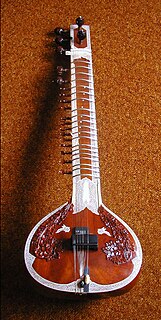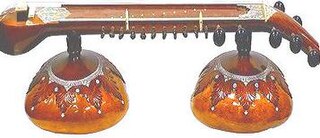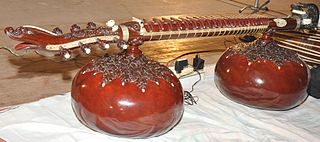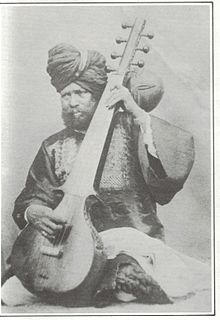
The guitar is a fretted musical instrument that usually has six strings. It is typically played with both hands by strumming or plucking the strings with either a guitar pick or the finger(s)/fingernails of one hand, while simultaneously fretting with the fingers of the other hand. The sound of the vibrating strings is projected either acoustically, by means of the hollow chamber of the guitar, or through an electrical amplifier and a speaker.

The sitar is a plucked stringed instrument, originating from the Indian subcontinent, used in Hindustani classical music. The instrument flourished under the Mughals, and it is named after a Persian instrument called the setar. The sitar flourished in the 16th and 17th centuries and arrived at its present form in 18th-century India. It derives its distinctive timbre and resonance from sympathetic strings, bridge design, a long hollow neck and a gourd-shaped resonance chamber. In appearance, the sitar is similar to the tanpura, except that it has frets.
The sarod is a stringed instrument, used mainly in Hindustani music on the Indian subcontinent. Along with the sitar, it is among the most popular and prominent instruments. The sarod is known for a deep, weighty, introspective sound, in contrast with the sweet, overtone-rich texture of the sitar, with sympathetic strings that give it a resonant, reverberant quality. It is a fretless instrument able to produce the continuous slides between notes known as meend (glissandi), which are important in Indian music.

Pandit Shivkumar Sharma is an Indian music composer and santoor player from the state of Jammu and Kashmir. The santoor is a folk instrument.

The chitravina is a 20 or 21-string fretless lute in Carnatic music. Around the late 19th and early 20th centuries, it started to be known by another name, Gotuvadyam, which was bestowed upon it by Sakha Rama Rao from Tiruvidaimarudur, who was responsible for bringing it back to the concert scene.

A mohan veena is either of two distinct plucked string instruments used in Indian classical music, especially Hindustani classical music which is associated with the northern parts of the Indian subcontinent. A modified sarod, created by sarod player Radhika Mohan Maitra in the 1940s, was called the mohan veena. The instrument was so named by musicologist Thakur Jaidev Singh, then the chief producer at All India Radio. Later Vishwa Mohan Bhatt modified a Hawaiian guitar to create an instrument also called the mohan veena, with Bhatt naming the instrument after himself. The latter instrument has become more closely associated with the name, especially following Bhatt winning the Grammy Award in 1994.

Vishwa Mohan Bhatt, also known as V. M. Bhatt, is Grammy-winning Hindustani classical music instrumentalist who plays the Mohan veena .,

Vidushi Dr.Kamala Shankar a renowned first lady Indian Classical Slide Guitar musician has enthralled the world through her immaculate and melodious rendition of Hindustani Classical music. Kamala has the credit to invent the Shankar Slide Guitar. She is known for her tremendous control and versatility along with the depth on her instrument. She has an exceptional and natural ability to play the ‘Gayaki Ang’ style.Her music is popularly referred as singing guitar.

Rudra veena, is a large plucked string instrument, originating from the Indian subcontinent, used in Hindustani classical music, one of the major types of veena played in Indian classical music.

The vichitra veena (Sanskrit: विचित्र वीणा is a plucked string instrument used in Hindustani music. It is similar to the Carnatic gottuvadhyam. It has no frets and is played with a slide.

The Sarasvati vīṇa is an Indian plucked string instrument. It is named after the Hindu goddess Saraswati, who is usually depicted holding or playing the instrument. Also known as raghunatha veena is used mostly in Carnatic Indian classical music. There are several variations of the veena, which in its South Indian form is a member of the lute family. One who plays the veena is referred to as a vainika.
Lalmani Misra was an eminent Indian classical musician known as much for his art as for his scholarship.
Pandit Budhaditya Mukherjee is an Indian classical sitar and surbahar maestro of the Imdadkhani gharana (school), recognizable by his intricate vocalic playing complemented by spectacular high speed playing. He holds a unique distinction of being the ever first artist in history to perform in the House of Commons, London. Famously proclaimed the "sitar artist of the century" by veena great Balachander, he has performed in thousands of concerts since the 1970s in India, America, Australia, the UAE, and almost all of Europe.
Pandit Jayateerth Mevundi is an Indian classical vocalist of the Kirana gharana.

The sursingar, sursringar or surshringar, is a musical instrument from India having many similarities with the sarod. It is larger than the sarod and produces a deeper sound. It precedes the sarod chronologically. In Dhrupad style it was used as a solo instrument in the 19th and 20th centuries. It is regarded as a further development of the Dhrupad-Rabab that has more or less disappeared today Its neck has a metal fingerboard and the steel and bronze strings are played with a metal pick, while the bridge is made of a flat horn. It has two resonant boxes; the main box is made from a cut gourd, on which a wooden cover is attached.
The veena is a plucked musical instrument originating from India.

Pandit Gopal Krishan was an exponent of vichitra veena, an ancient Indian musical instrument. He is arguably the best Vichitra Veena player of all times.
The ancient veena is an early Indian arched harp, not to be confused with the modern Indian veena which is a type of lute. The instrument is attested on a gold coin of the Gupta Empire from the mid-300s CE.

The veena, comprises a family of chordophone instruments of the Indian subcontinent. Ancient musical instruments evolved into many variations, such as lutes, zithers and arched harps. The many regional designs have different names such as the Rudra veena, the Saraswati veena, the Vichitra veena and others.

Ranjan Veena is a plucked string musical instrument invented and patented by Pandit Niranjan Haldar, a retired senior Grade-A artist from All India Radio.












